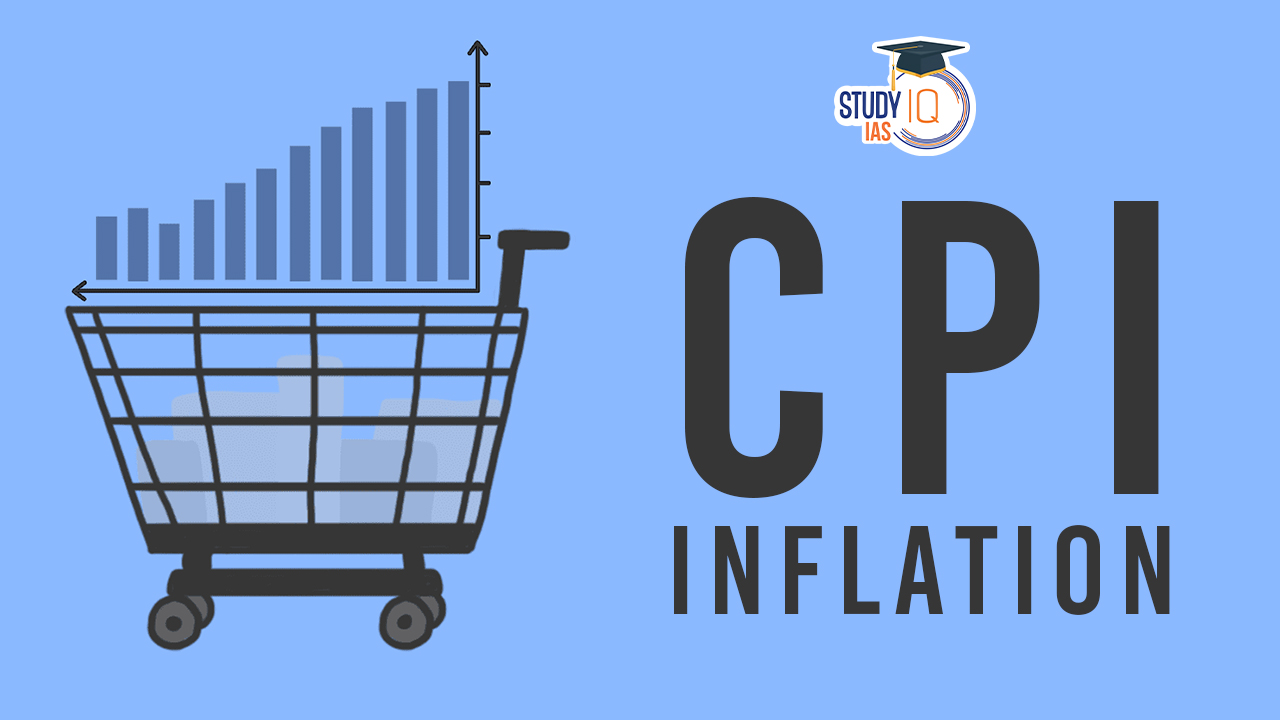Table of Contents
Context: India’s Consumer Price Index (CPI) based inflation rate touched 5.7% in December 2023.
What Is CPI Inflation?
- The consumer price index measures “changes over time in the general level of prices of a basket of selected goods and services that households acquire for consumption.” – Ministry of Statistics and Programme Implementation (MoSPI).
- It is released monthly by the National Statistical Office (NSO), Ministry of Statistics and Programme Implementation (MoSPI).
- At an all-India level, the current CPI basket comprises 299 items.
We’re now on WhatsApp. Click to Join
How Is CPI Inflation Calculated?
- Base Year: It is a reference point used for comparison to measure changes in price levels over time. Current base year is 2012.
- The price index is given a value of 100 for 2012 and changes from these price levels are then calculated to arrive at inflation rates for each good or service.
- According to the National Statistical Office within the MoSPI, the monthly price data is collected from 1181 villages and 1114 urban markets spread all across the country.
- The data for this purpose is collected on a weekly basis by the field staff of NSO.
What Are the Components of CPI Inflation?
The Consumer Price Index (CPI) comprises six primary categories, each with different importance and various subcategories. These main components are:
- Food and Beverages: This is the most significant section, accounting for 45% of the total index. Within this, cereal prices are particularly influential, making up67% of the CPI.
- Pan, Tobacco, and Intoxicants: This category includes items like pan, tobacco products, and various intoxicants.
- Clothing and Footwear: This segment covers all types of apparel and footwear items.
- Housing: This component reflects costs associated with housing, such as rent.
- Fuel and Light: This includes expenses for energy sources like electricity and fuel.
- Miscellaneous: This diverse category encompasses services like education and healthcare, and it’s the second most significant component after food and beverages.
Analysing Inflation Rates

The analysis of inflation rates can be approached in two distinct ways:
- Year-on-Year (YoY) Increase: This method involves comparing the price level of a given month (e.g., December) with the price level in the same month of the previous year (e.g., December of the last year).
- The resulting rate is the year-on-year increase. This is the most common way to calculate inflation.
- Month-on-Month (MoM) Change: This calculation compares the prices of one month (e.g., December) with the prices in the preceding month (e.g., November).
- Recent data indicates that while the year-on-year inflation rate rose towards the end of 2023, the month-on-month data for December showed deflation.
- Deflation: It is the term used to describe a situation where prices drop from one period to the next.
- It is important to note that deflation is different from disinflation, which refers to a slowdown in the rate of inflation from one month to another.
- Regarding the various components of inflation, a significant rise in food prices was responsible for the increase in year-on-year inflation in December. Specifically:
- Vegetable prices surged by nearly 28% compared to December 2022.
- Pulse prices increased by 21%, and spices by 20%.
- Cereal prices also went up by 10%.
- These four food groups alone, which represent 23% of the total CPI weight, were key drivers in the overall inflation rate increase.
- Finally, inflation rates continued to vary across different regions of the country. Odisha recorded the highest inflation at 8.7%, while Delhi experienced the lowest at 2.9%.
Significance and Concerns Of Recent Data
Significance
- Inflation Outlook: Analysts predicted a decline in inflation rates in the coming months, attributing this to factors such as the Kharif harvest and government measures aimed at reducing food inflation.
- Annual Inflation Projection: For the entire financial year, inflation is expected to average around 5.5%, with March 2024’s inflation rate forecasted to be about 5%.
- Core Inflation Trend: Even as overall inflation fluctuates, the core inflation rate (which excludes food and fuel prices) has been on a downward trend.
Concerns
- Impact on Monetary Policy: The recent uptick in inflation, particularly in November and December, is likely to postpone any reduction in interest rates, affecting loan EMIs.
- Previously, there was speculation that the RBI might cut rates as early as April, but now rate cuts are not expected before August.
- RBI’s Stance: The Reserve Bank of India (RBI) is cautious about the secondary effects of food price volatility on achieving policy objectives.
- Experts believe that the RBI will maintain its current stance on monetary policy and rates, potentially leading to only a modest rate cut starting in August 2024.
- Challenges for Fiscal Policymakers: Rising inflation poses difficulties for fiscal policymakers. This includes political challenges due to the proximity to elections, and the complications it brings to budget planning, where uncertainty around inflation is problematic.


 Coconut Oil Taxation in India
Coconut Oil Taxation in India
 Pariksha pe Charcha 2025, Overview, Even...
Pariksha pe Charcha 2025, Overview, Even...
 National Policy on Framework on Agricult...
National Policy on Framework on Agricult...




















